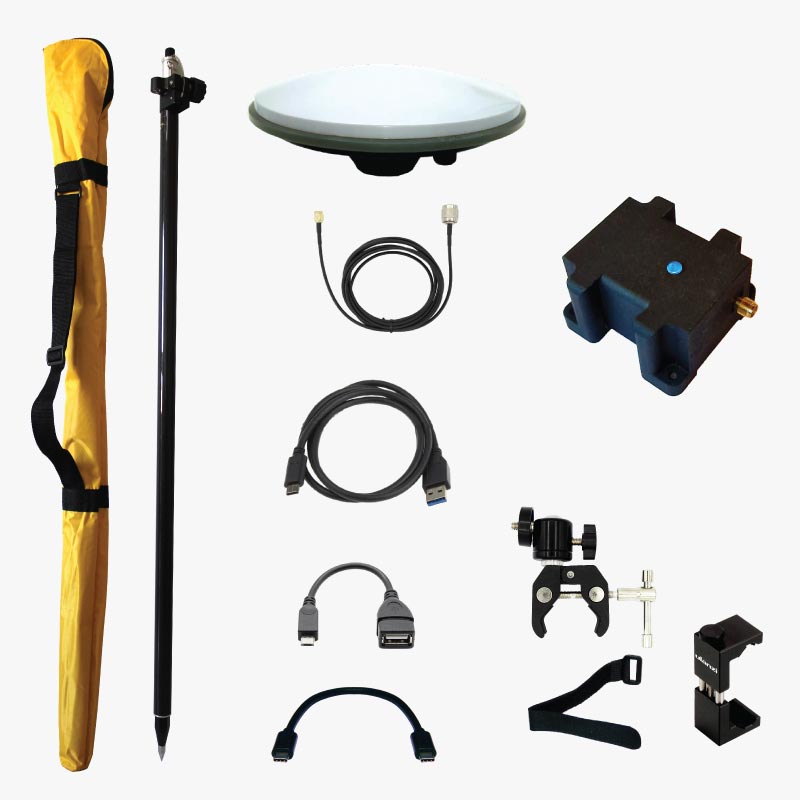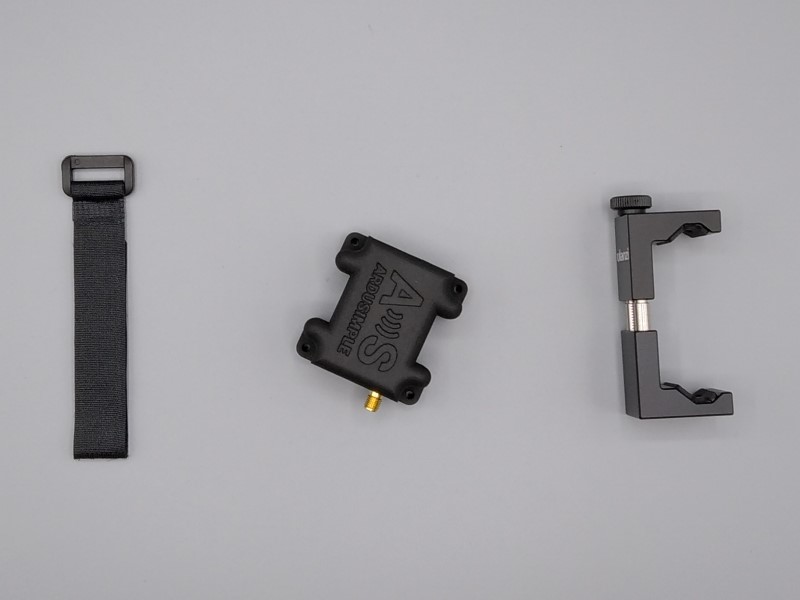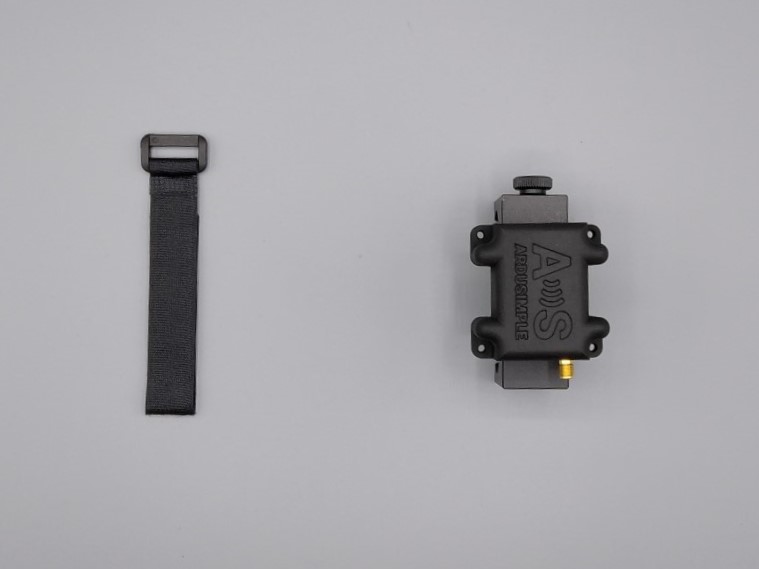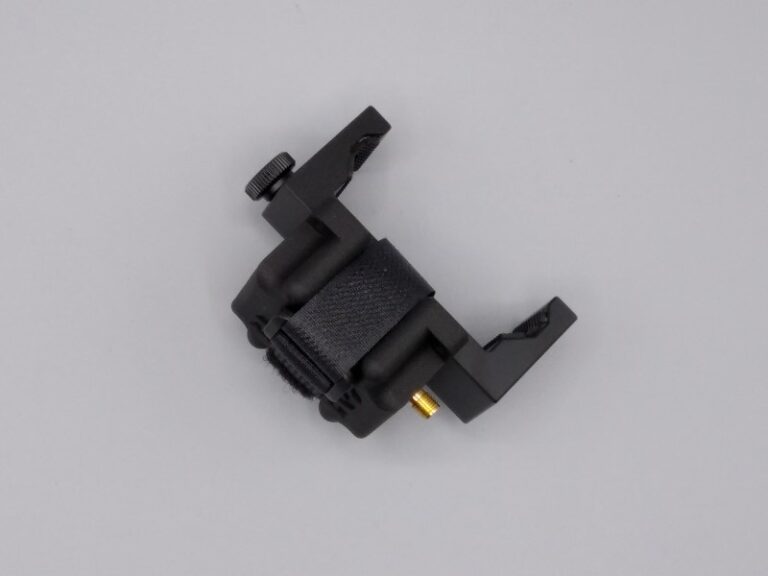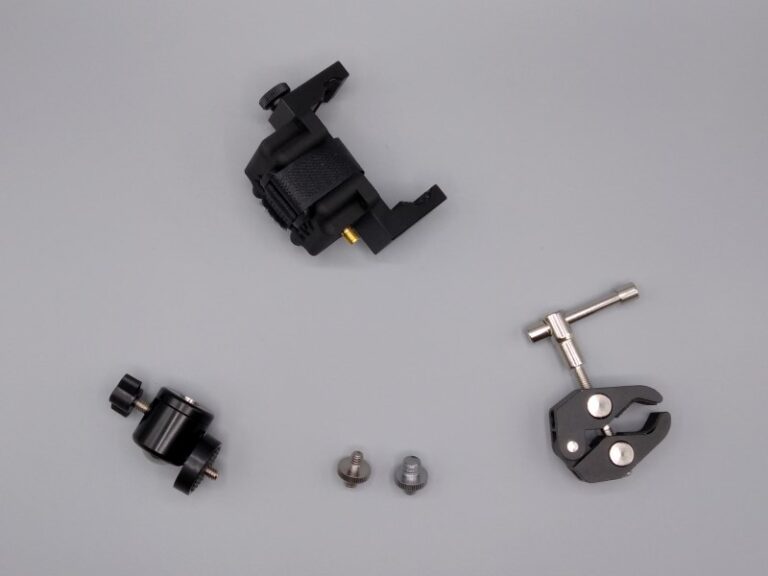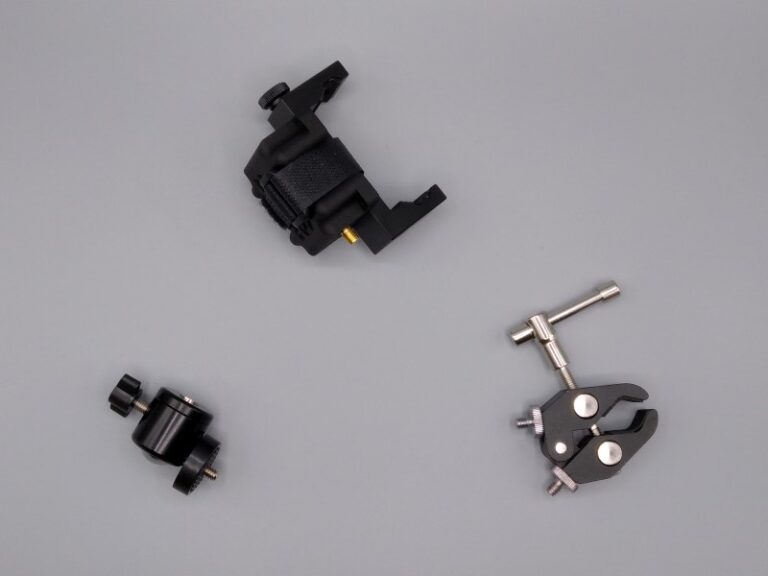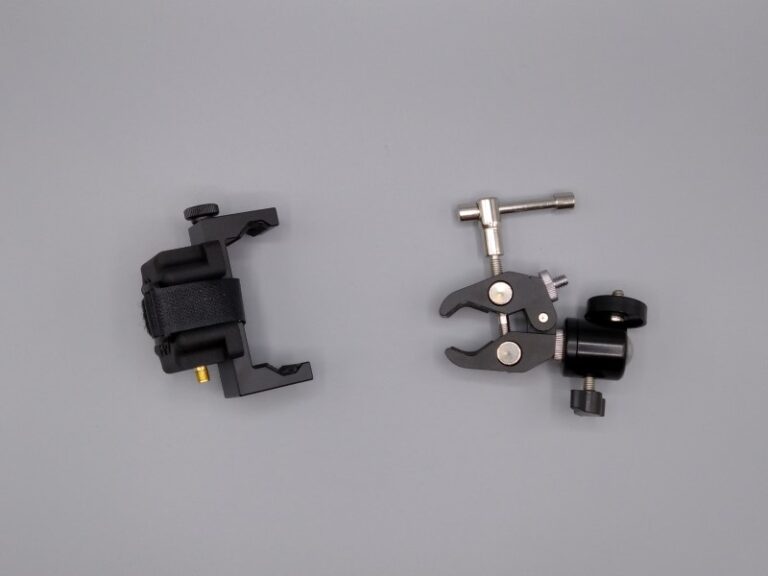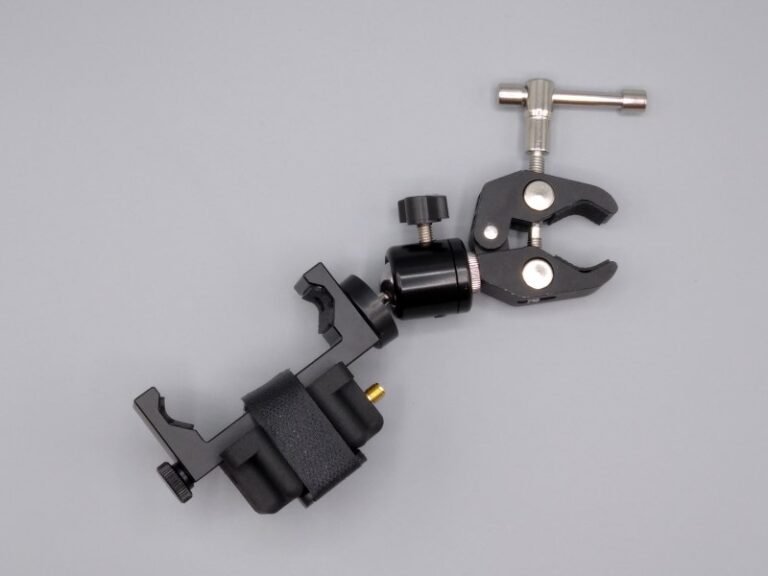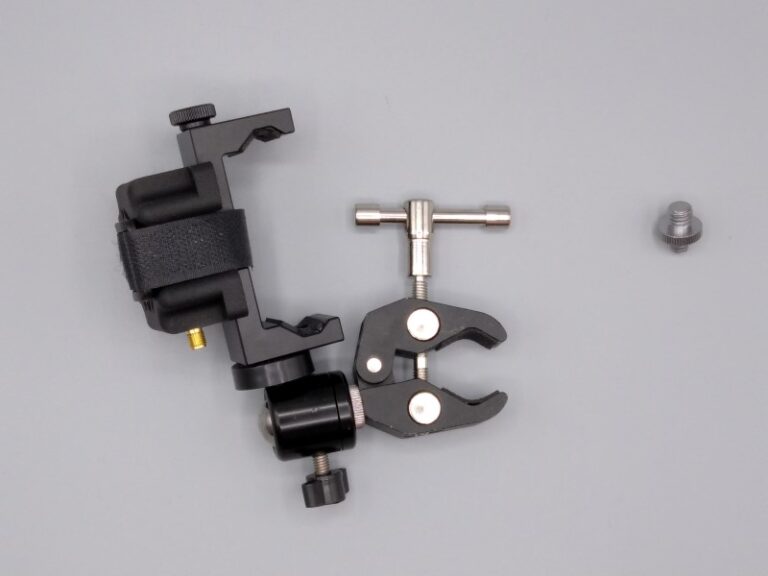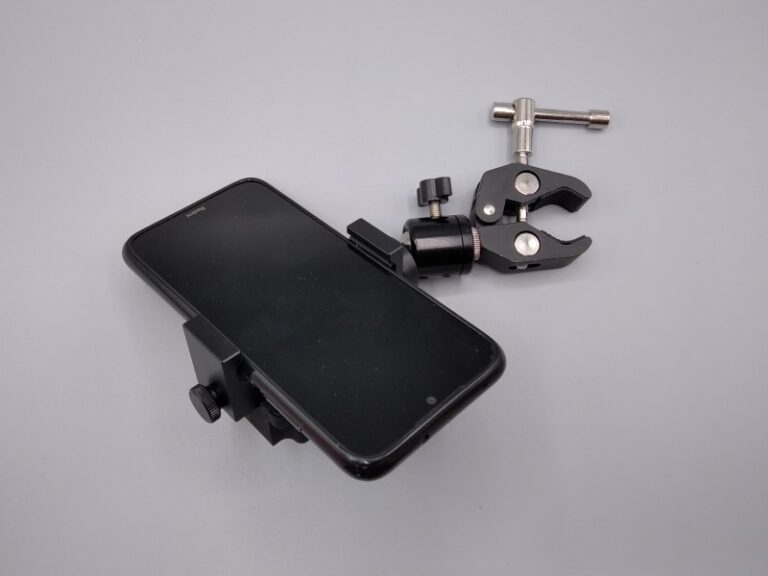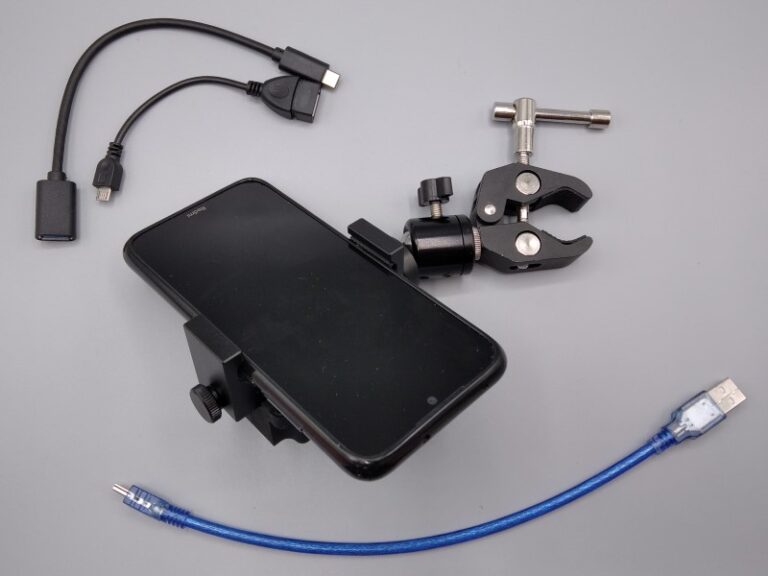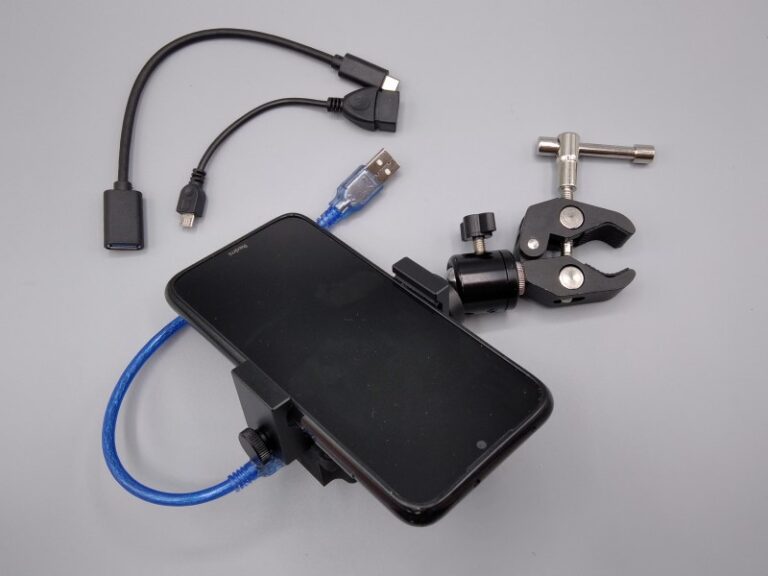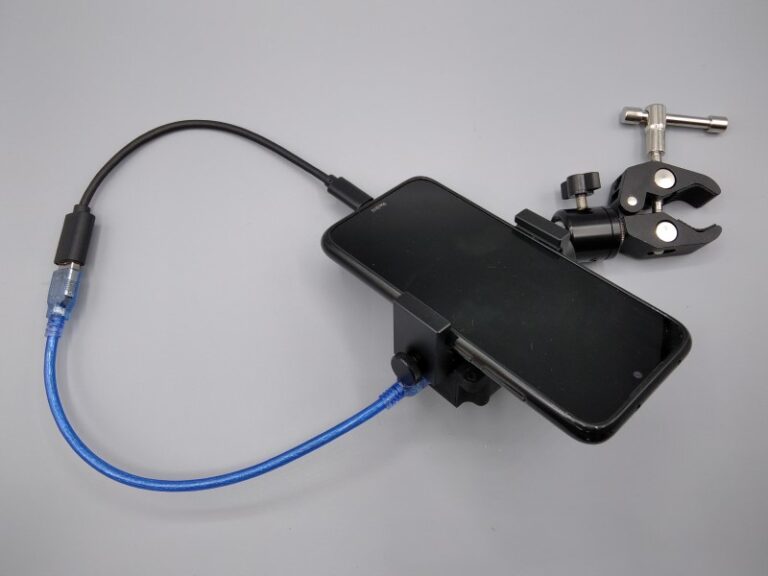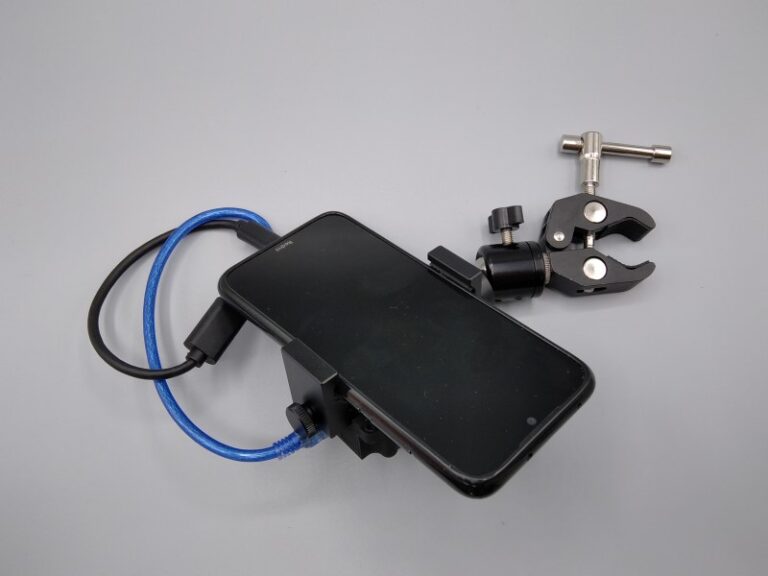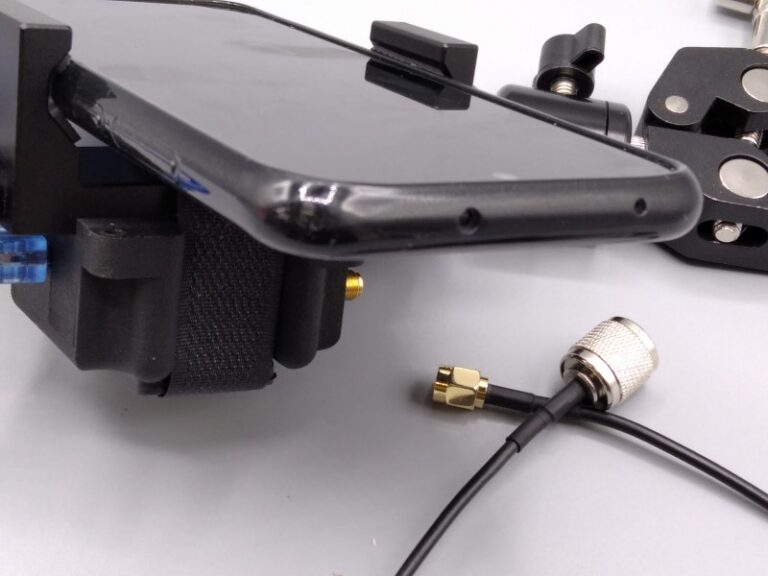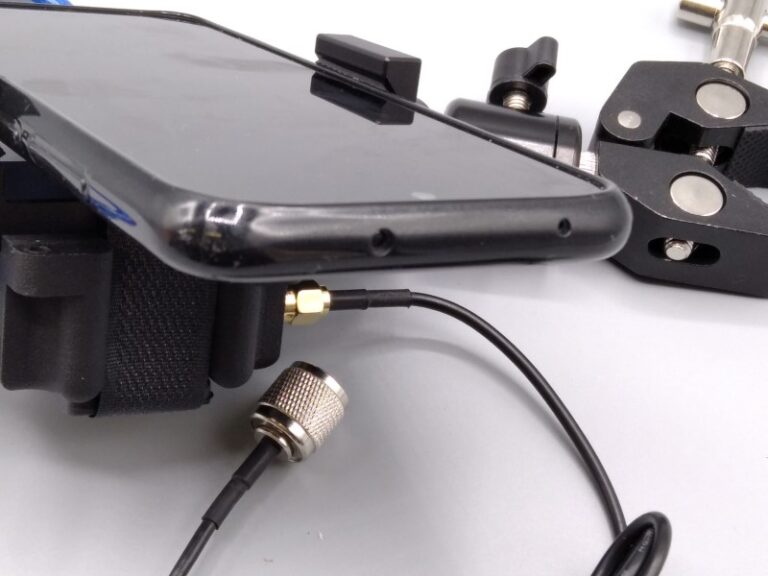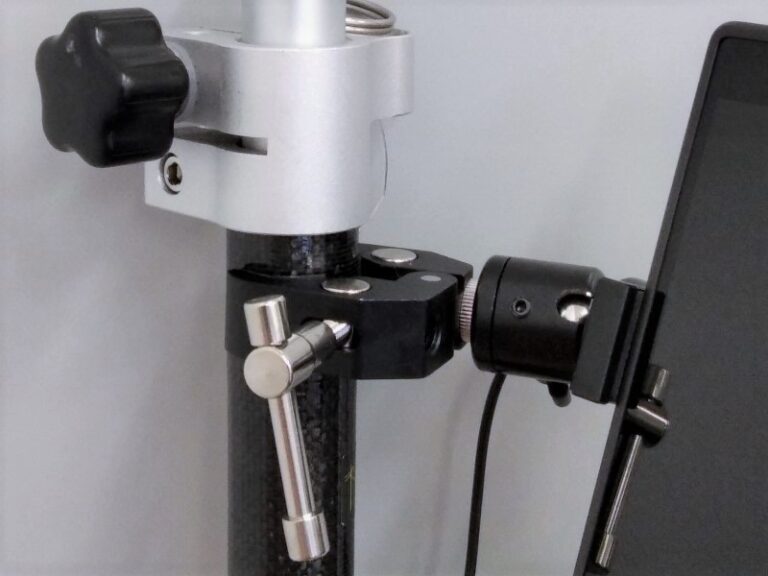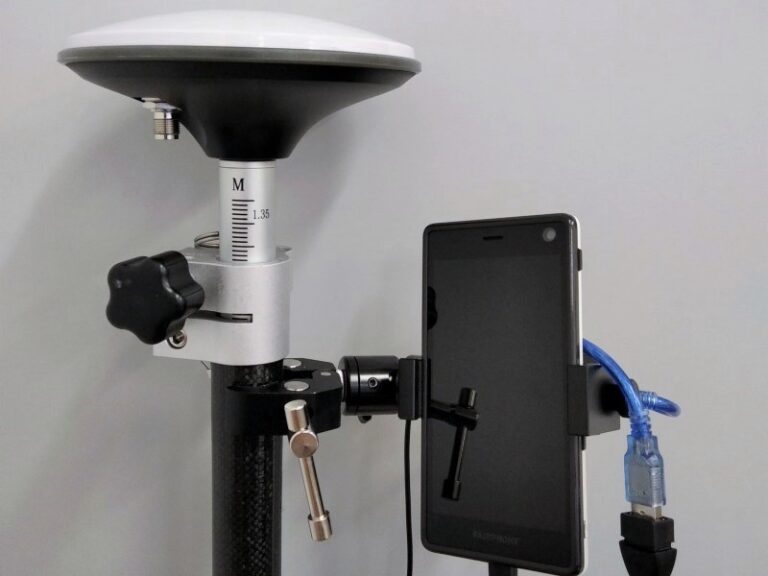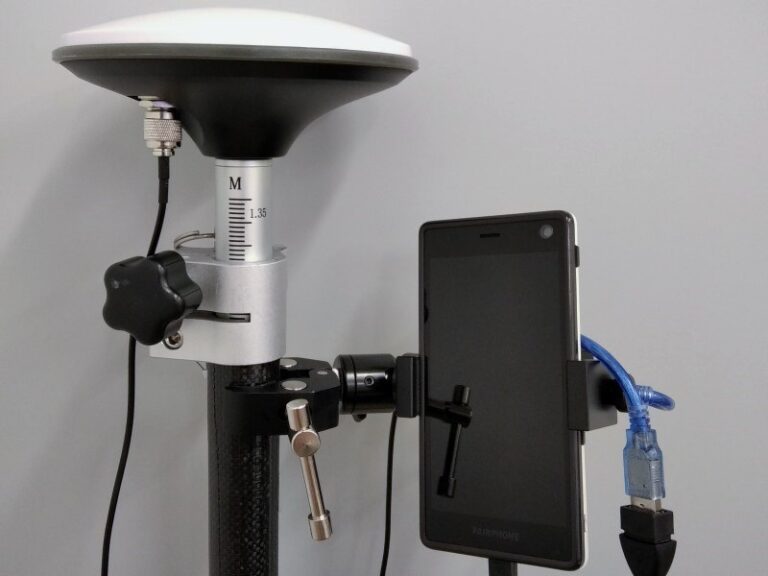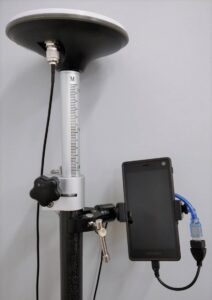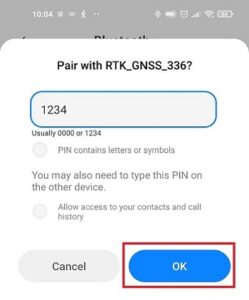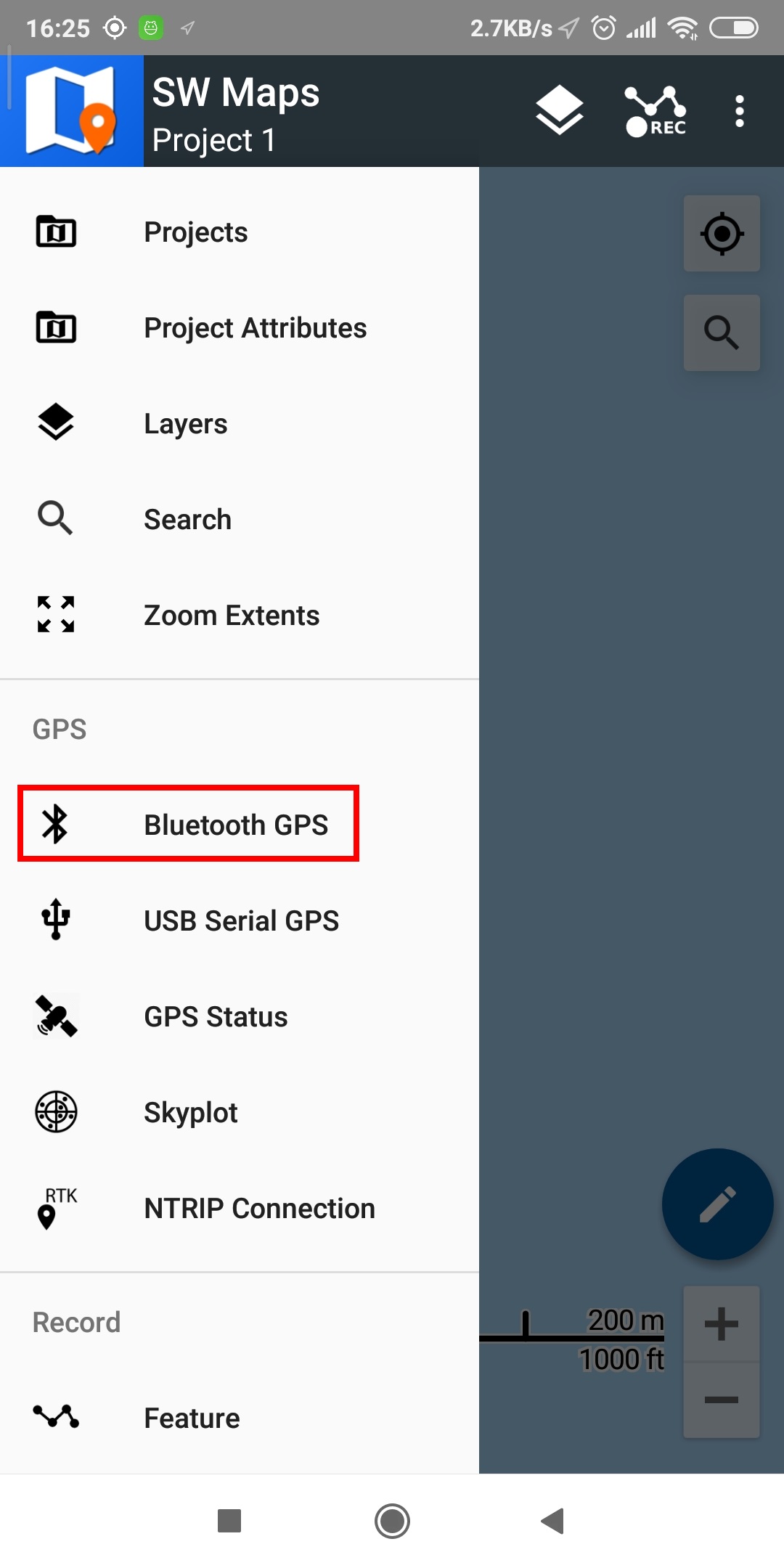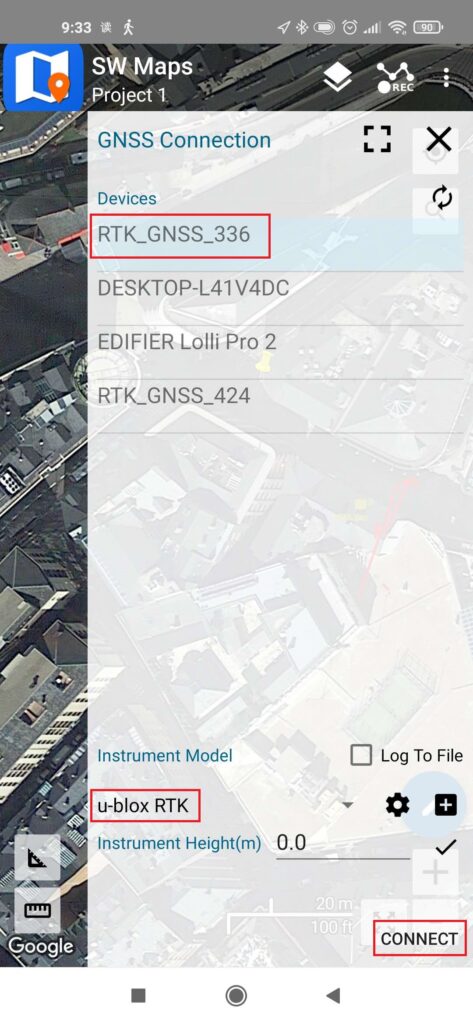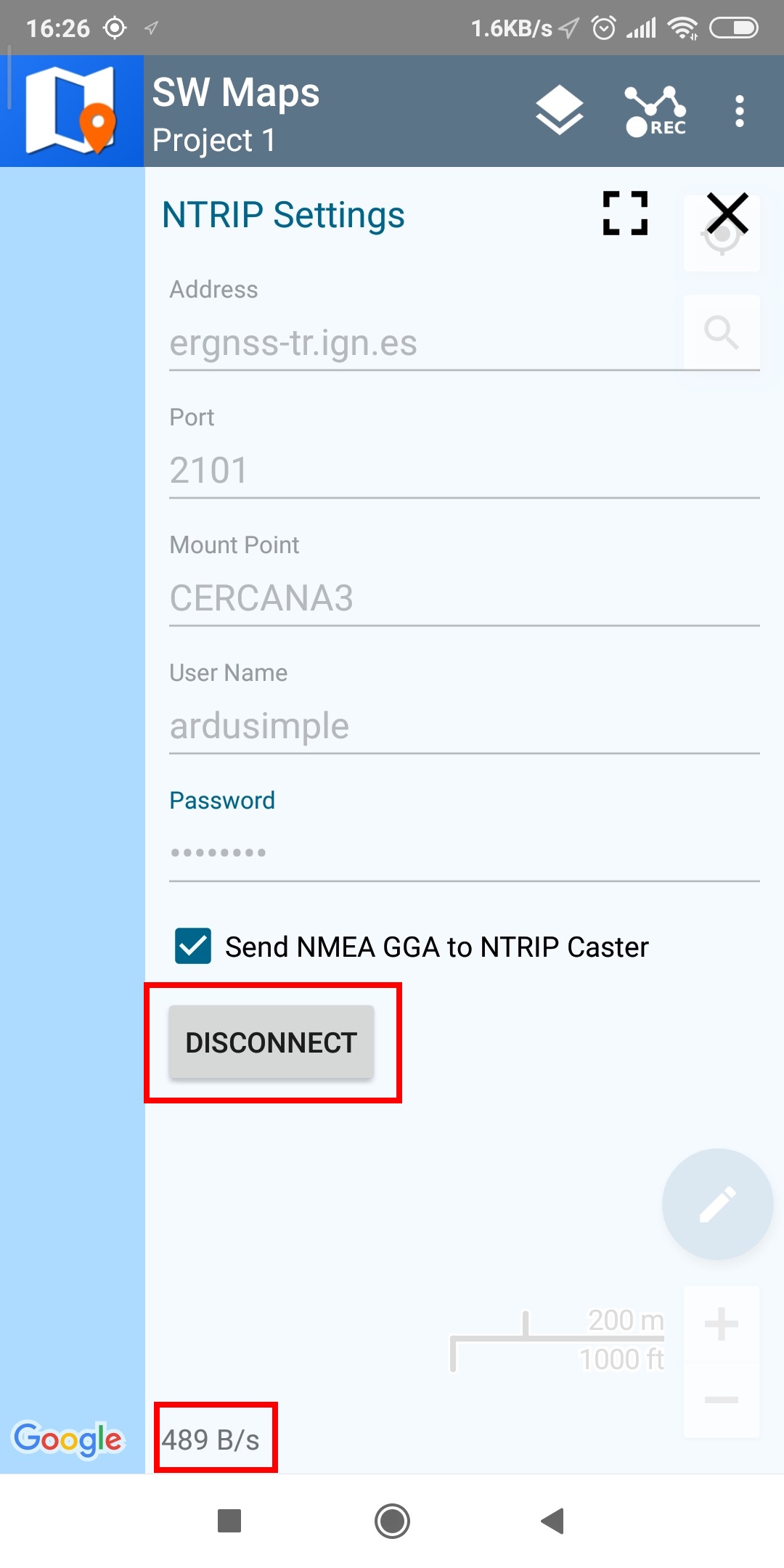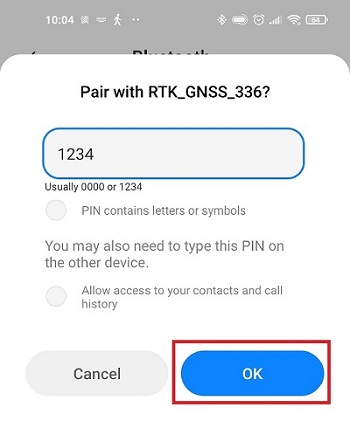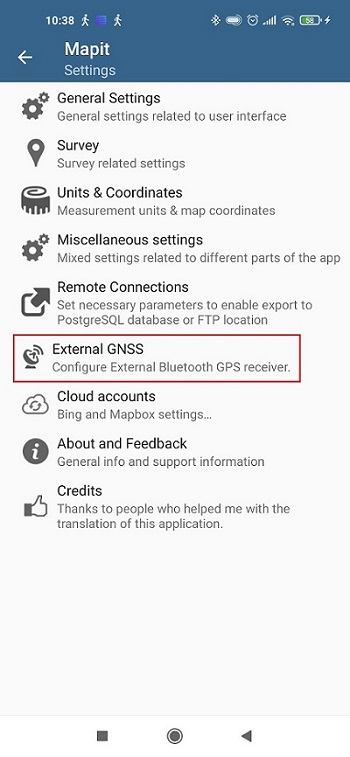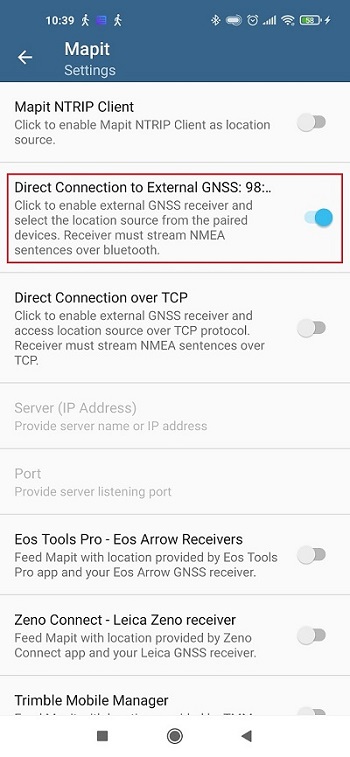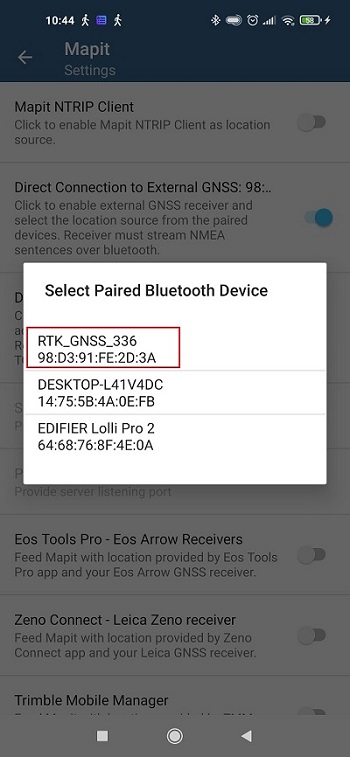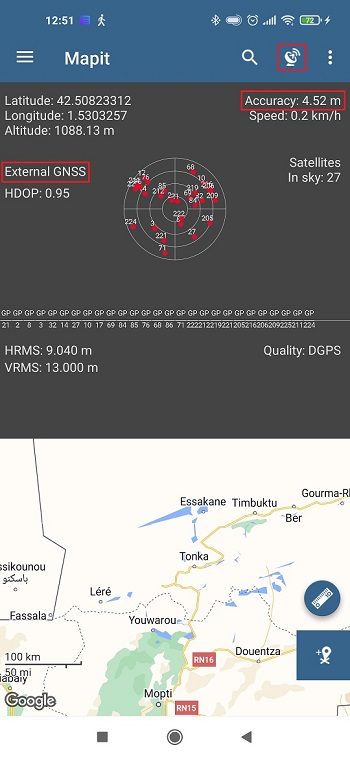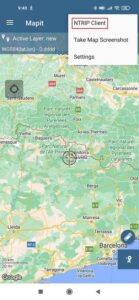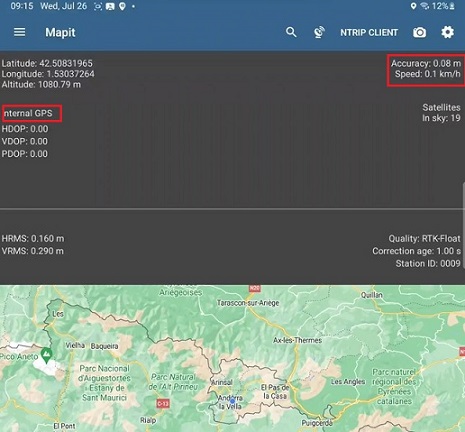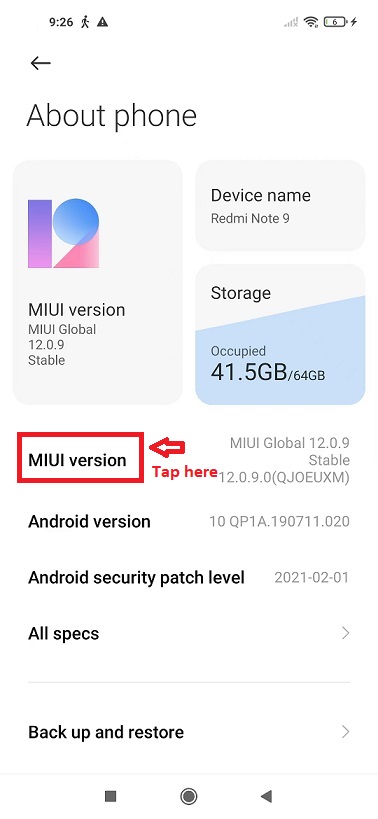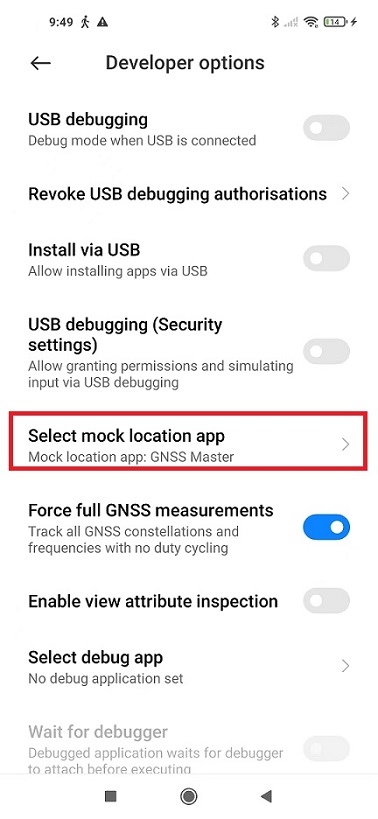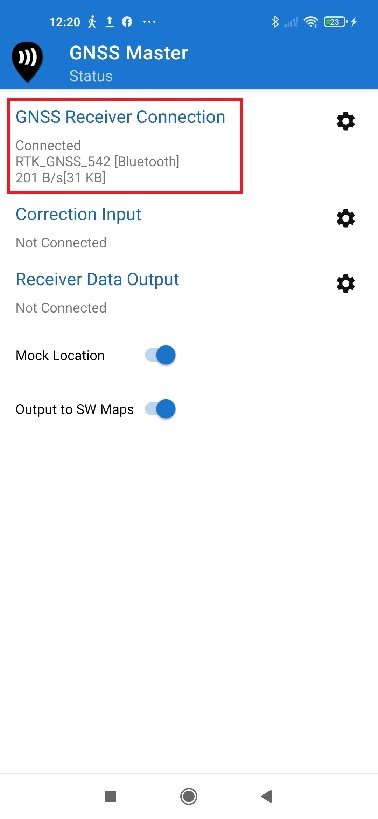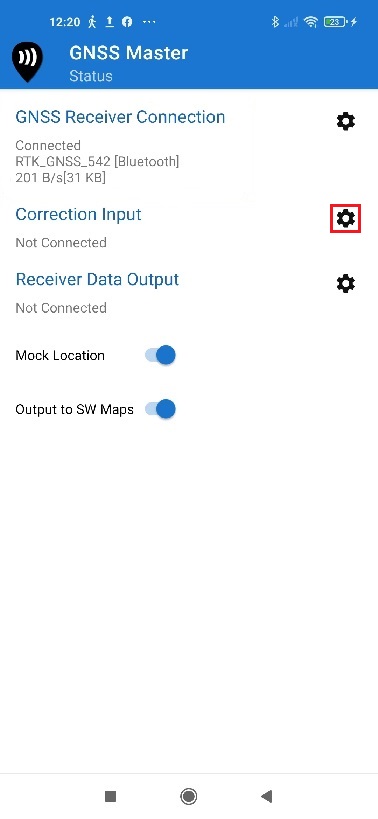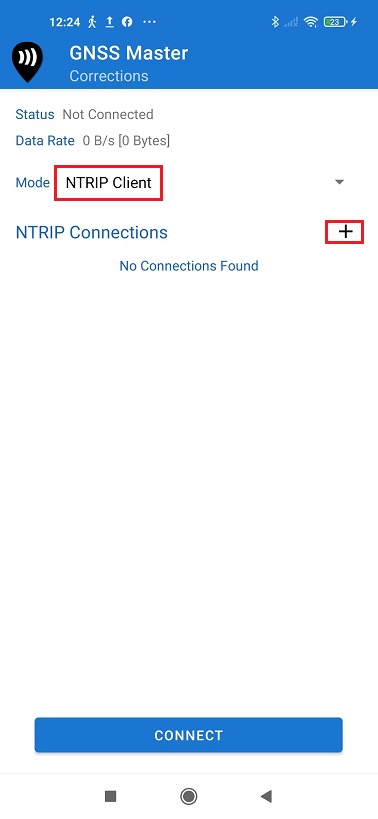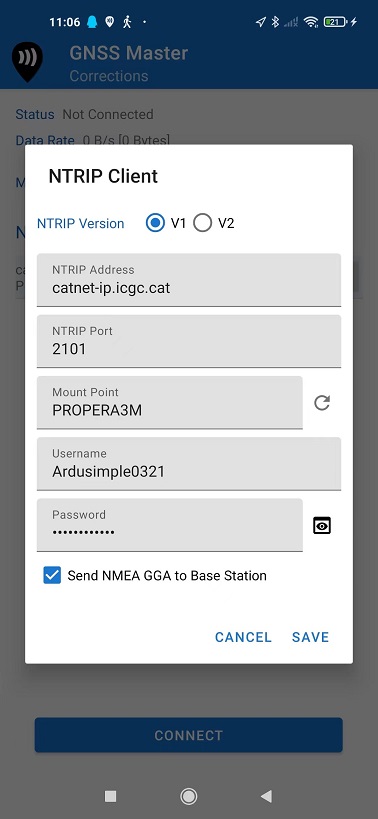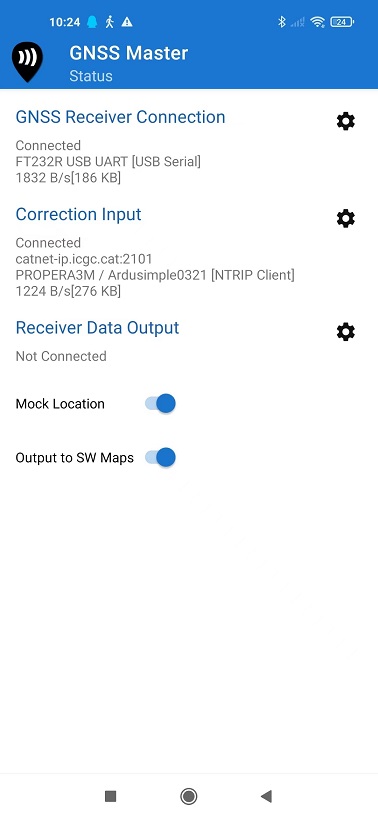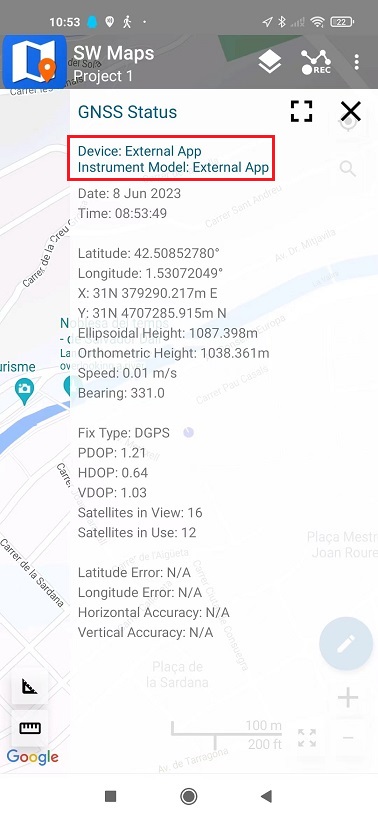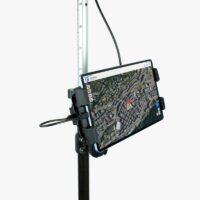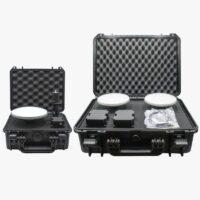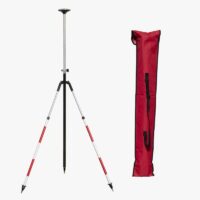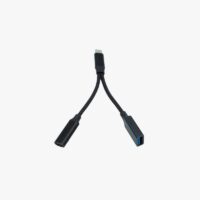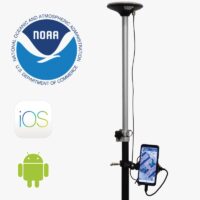User Guide: RTK Calibrated Surveyor Kit
Overview
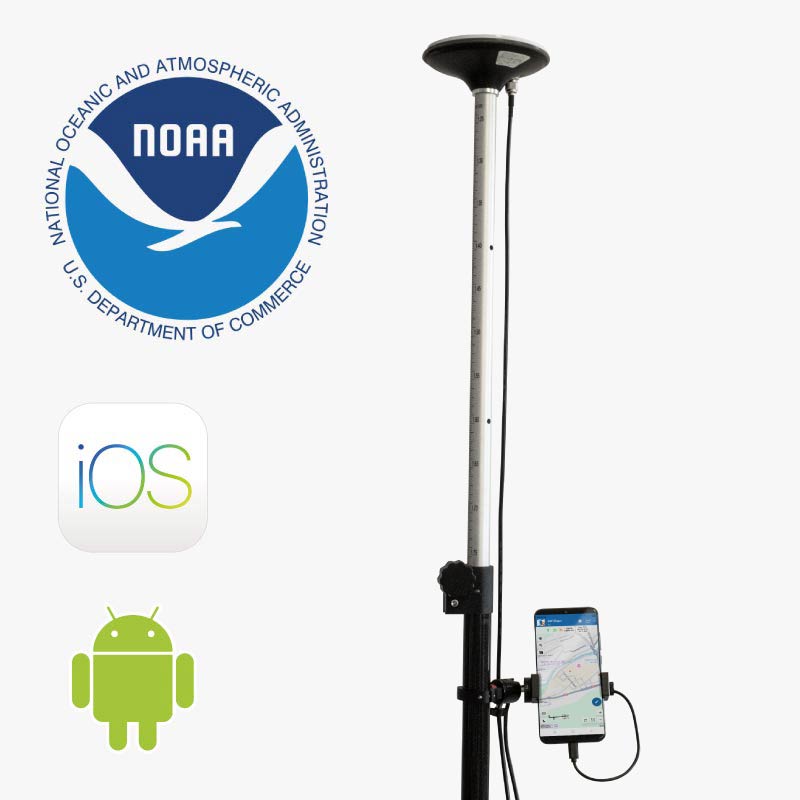
Traditional survey performance at affordable cost. Includes accessories.
With the RTK Calibrated Surveyor Kit you will have everything you need to start your surveying tasks with RTK and centimeter level accuracy.
Package
You got your new RTK Calibrated Surveyor Kit? Follow the installation manual to get your kit set up quickly.
Remember all the component parts of RTK Calibrated Surveyor Kit includes:
- ZED-F9P RTK receiver with USB and Bluetooth inside a plastic case
- Survey calibrated antenna with 1.5m TNC-SMA cable
- Mini USB cable
- USB OTG microUSB-B (14cm)
- USB OTG type C (22cm)
- Universal smartphone holder with 3M-Backed Rubber Pads, fits any smartphone from 5.3cm to 9.3cm with or without case
- Clamp to hold the smartphone holder to the pole
- Velcro strap (20cm) to fix the receiver to the back of the smartphone holder
- Surveying Pole for survey GNSS antenna
The kit is pre-configured to send NMEA data simultaneously via Bluetooth and USB.
Unboxing
For building RTK Calibrated Surveyor Kit, there is no need for special tools nor nothing of the sort, by hand will be enough. Follow the quick guide to set up.
2. Place the case together with the smartphone holder with the SMA connector inversely positioned to the smartphone holder width adjusting screw. You may observe that the flat face of the case fits with the back of the smartphone holder. Fasten it together with the Velcro strap.
4. Join the main parts of the clamp with the preferred screw. Each screw fits different screw holes within the clamp. You can screw in both and decide which may work best for you. Then, screw tightly together the rotating part of the clamp that will serve to rotate the smartphone holder to your preferred position.
14. You now got your RTK Calibrated Surveyor Kit built and ready to work!
15.The kit can be used for about 6-8 hours with an average phone powering.
Note: If the you need more than this, use USB-C on-the-go (OTG) with external USB-C power supply (optional, not included in the package of the Surveyor kit) and a small external 1’000mAh powerbank.
How to connect to your smartphone?
In the following integration guide we will explain how to use your Android device with RTK Calibrated Surveyor Kit.
- Make sure your device supports Bluetooth 2.0 or has USB OTG capabilities.
- Make sure your Android language is set to English, since some users reported compatibility problems with other languages.
- Place your RTK Calibrated Surveyor Kit in a location with good view of the sky, or near a window for testing the functionality.
- Download compatible software/app which you prefer to use from Google Play and install it in your device. We prepared step-by-step instructions how to useRTK Calibrated Surveyor Kit with several software/app:
- SW Maps – GIS & Data Collector. Use this link to download the app from Google Play and install it in your smartphone
- Mapit GIS. Use this link to download the app from Google Play and install it in your smartphone
- Other app. The list of compatible software/app you can find here.
How to use RTK Calibrated Surveyor Kit with SW Maps?
- Open SW Maps app and give permissions (first time only).
- Click on the SW Maps icon to show the app menu.
- Select USB Serial GPS.
- Under Devices, you should see FT232R USB UART. Set BaudRate to 115200 bps (if you ordered your Professinal kit before 09.10.2023, set BaudRate to 38400 bps).
- Set Instrument Model to u-blox RTK. Set the Instrument Height according to the height of your pole or antenna, if you want to measure the location of the ground.
- Click CONNECT button. When you click the CONNECT button, grant permissions (if asked).
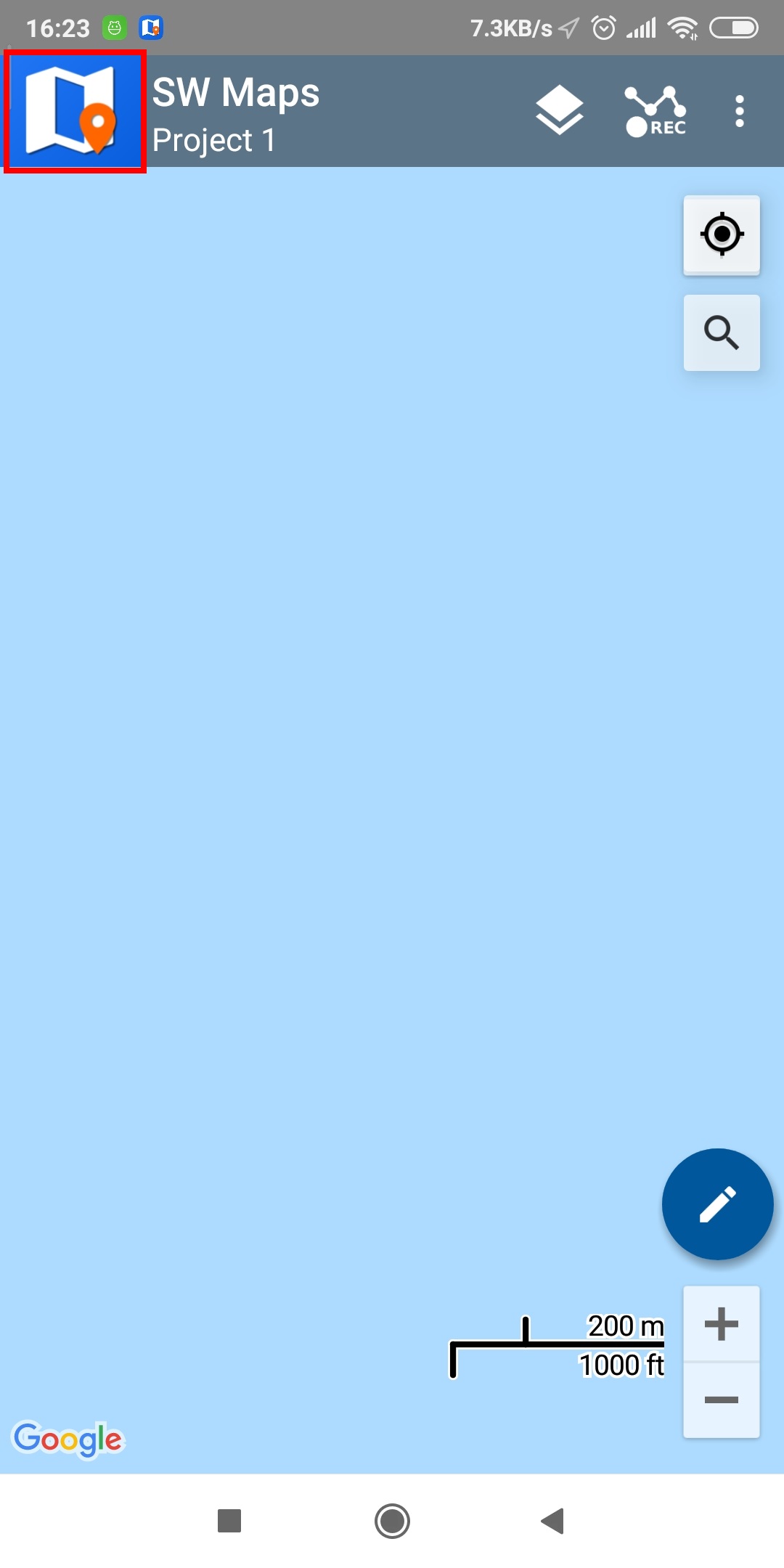
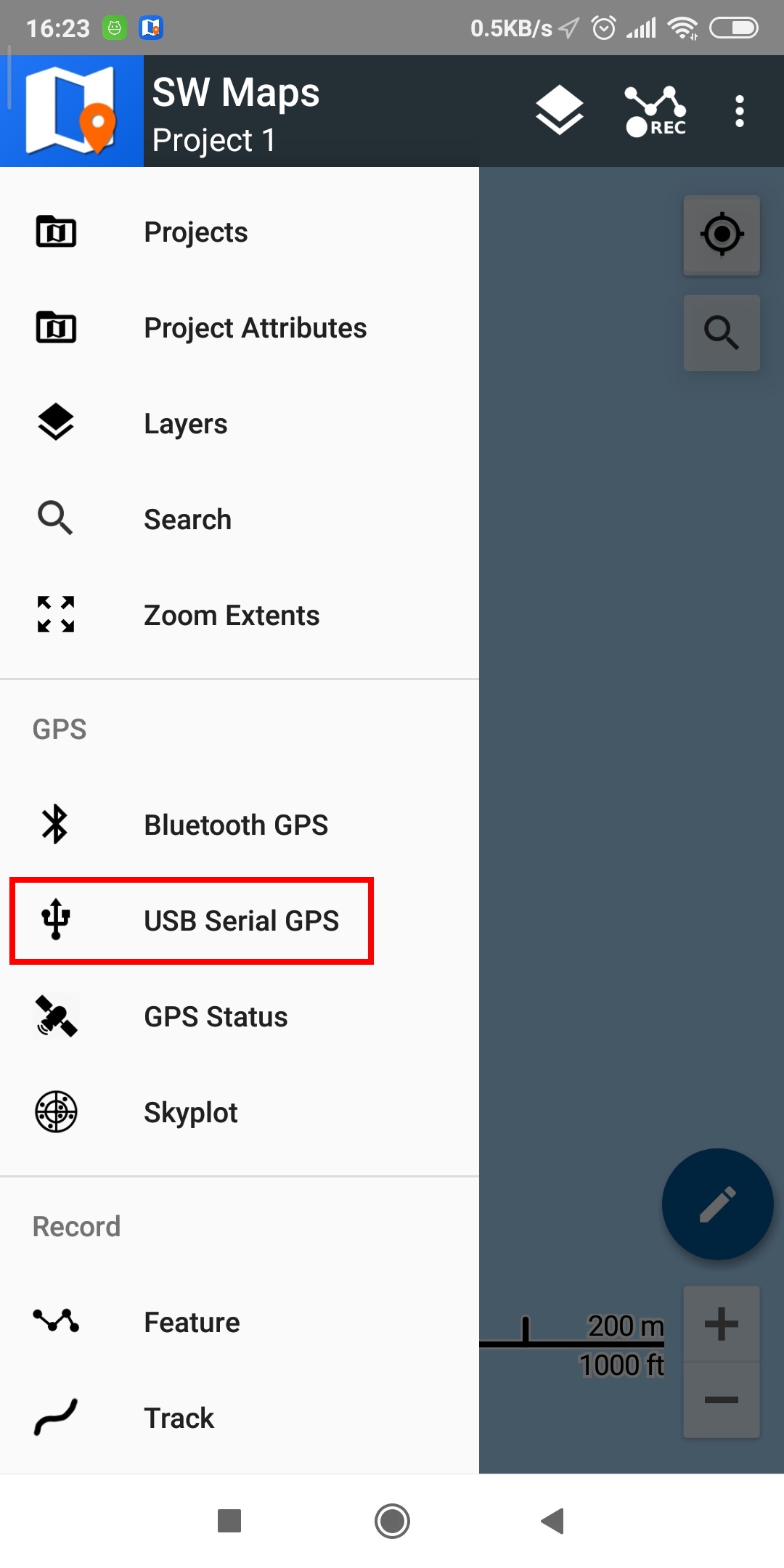

- Power your Ardusimple kit using its USB connector. Use a USB power bank, power wall adapter, smartphone, laptop etc.
- Enable the Bluetooth connection on your device.
- Pair the Ardusimple board in the Android Bluetooth menu. When searching for devices, you may see only the MAC address, but once paired the name will update to BT+BLE_Bridge_XXXX, where XXXX is a random number. Password is 1234. The pairing only needs to be done once. Unlike other Bluetooth devices, it won´t show as “connected” until you click “connect” button in an app.
- Open SW Maps app and give permissions (first time only). Click on the SW Maps icon to show the app menu.
- Select Bluetooth GPS.
- Under Devices, select the one you paired in step 3. Set Instrument Model to u-blox RTK. Set the Instrument Height according to the height of your pole or antenna, if you want to measure the location on the ground.
Click CONNECT button. When you click the CONNECT button, grant permissions (if asked).
- Under Devices, select the one you paired in step 3. Set Instrument Model to u-blox RTK. Set the Instrument Height according to the height of your pole or antenna, if you want to measure the location on the ground.
- Since you have a RTK capable GNSS receiver, let’s connect it to a NTRIP server to get cm accuracy. Go back to SW Maps menu and select NTRIP Connection.
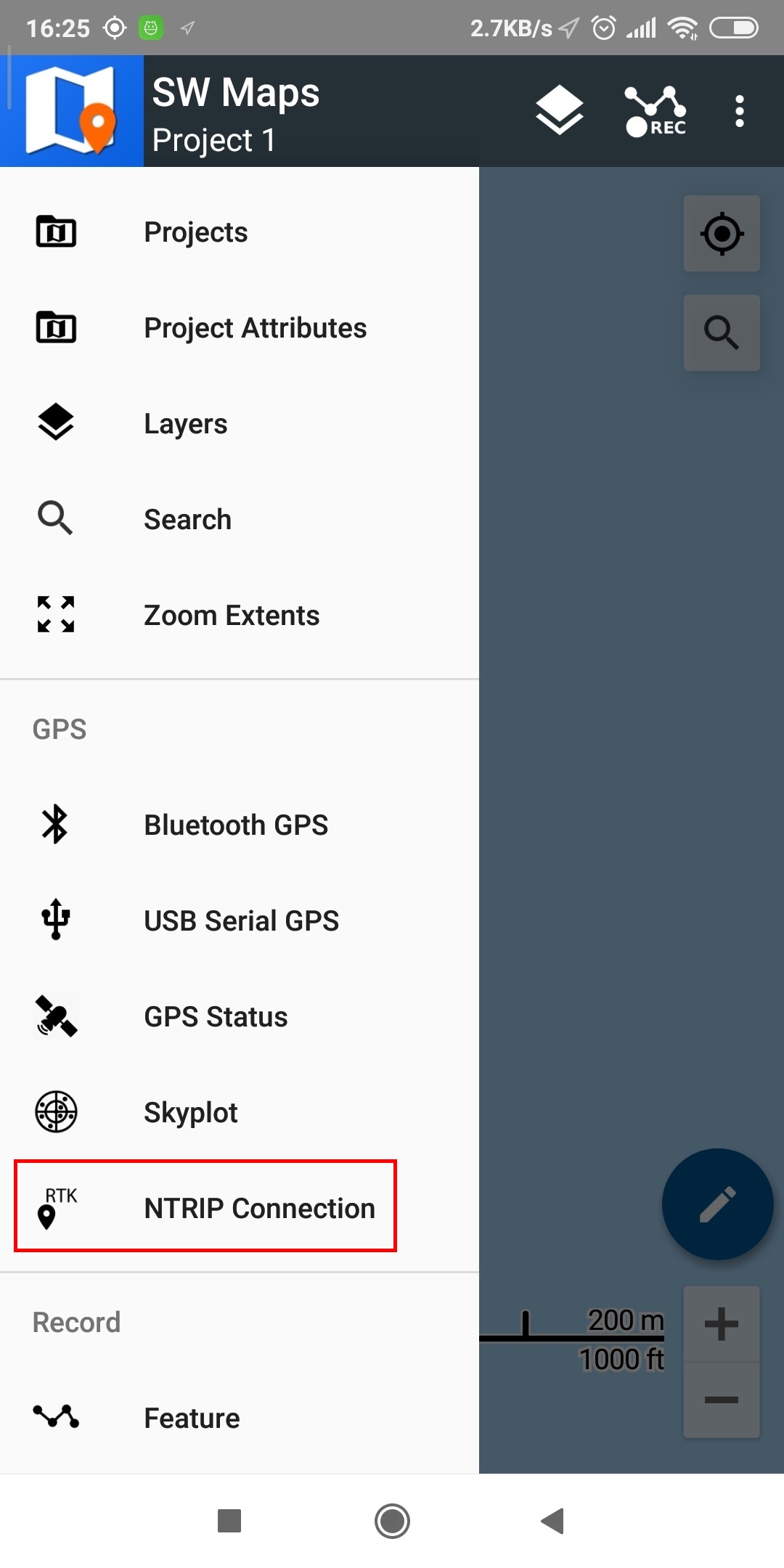
- Fill all the fields with your NTRIP provider data. Make sure to check Send NMEA GGA to NTRIP Caster if you are connecting to a VRS. If you do not know how to find NTRIP provider in your area, we have prepared a list of RTK Correction Services in your Country, check the page to find suitable service for you.
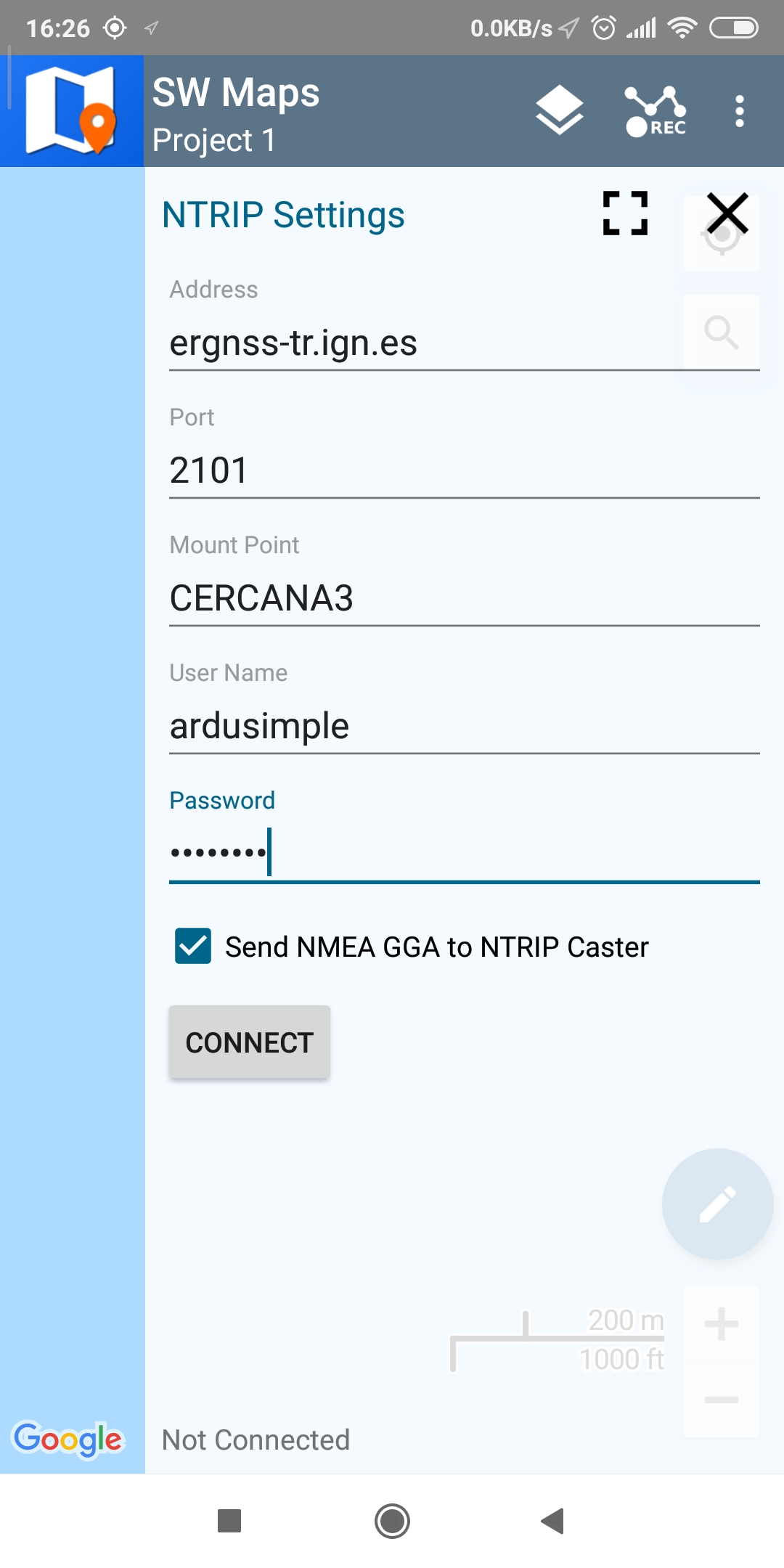
- When you click CONNECT, if everything worked, you will see the data stream alive.
- Go to the SW Maps menu and select GPS Status or Skyplot. You can see the actual position with centimeter accuracy in text format of your of your Ardusimple receiver and information about the satellites there.
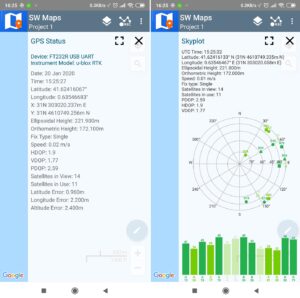
- You can click the button that is highlighted in red to make the app center the map in your receiver location. The pointer showing your location will change its color depending on the fix status of your receiver. Additionally, you have the option to adjust the map layer, include points, tracks, as well as import or export recorded locations, among other features.
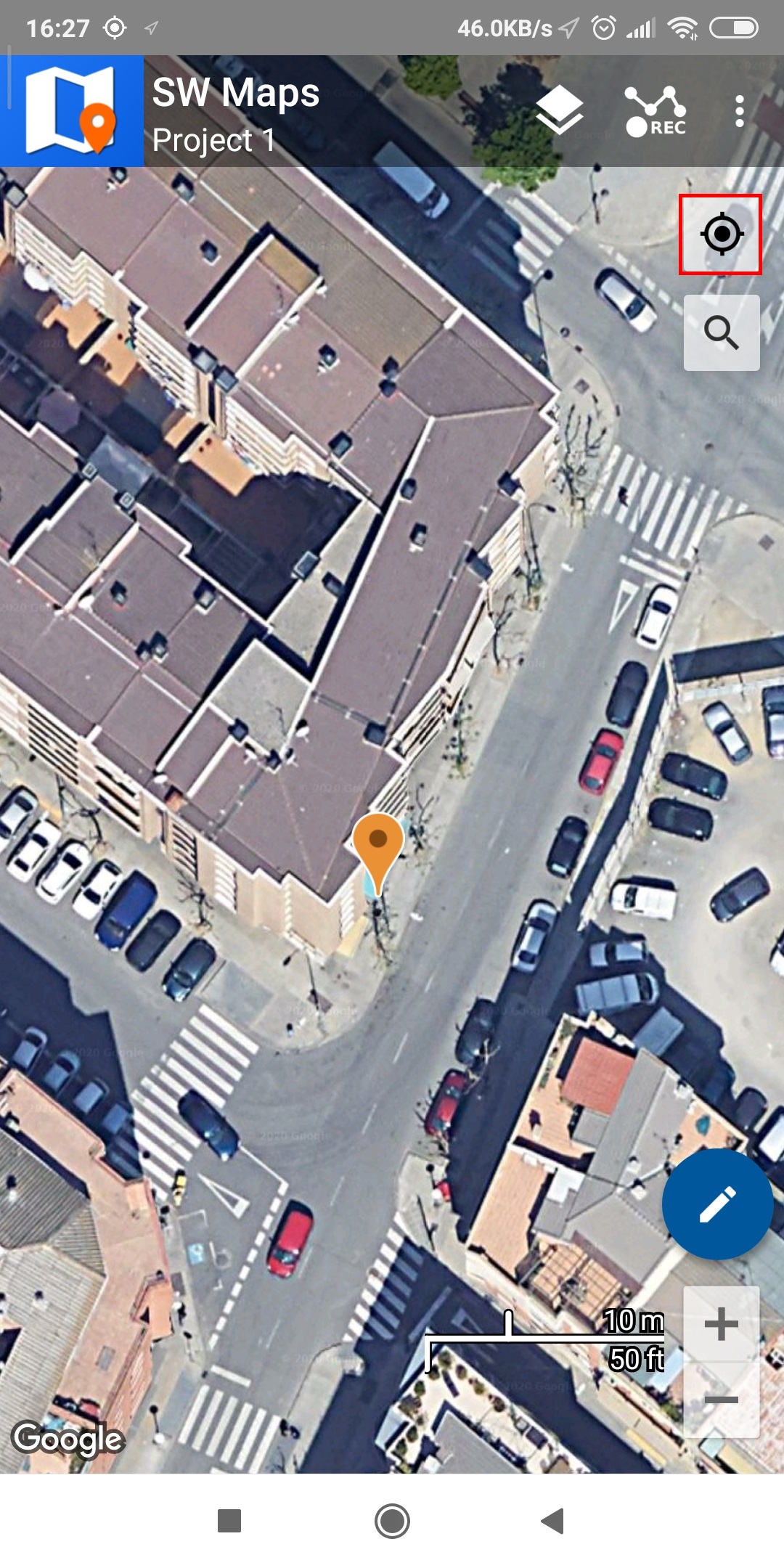
- You can get used to the SW Maps app by exploring its various options. If you prefer a guide, you can access the User Manual here.
How to use RTK Calibrated Surveyor Kit with Mapit GIS?
Firstly, pair your receiver to your Android smartphone or tablet.
- Power your RTK receiver by connecting USB cable to the power supply (smartphone/tablet/ compatible powerbank). If you get any pop-up message to connect the USB device with any app, you can ignore it.
- Enable the Bluetooth of your smartphone or tablet , and pair it with your RTK receiver.
When pairing your device, notice that it will appear as RTK_GNSS_***. The password is always 1234.
The pairing only needs to be done once. Unlike other Bluetooth devices, it won´t show as “connected” until you click “connect” button in an app.
- Place RTK antenna in a location with good view of the sky or near a window for testing the functionality.
Secondly, connect your receiver to Mapit GIS via Bluetooth.
- Open Mapit GIS. Go to Settings. Tap on External GNSS.
- Enable Direct Connection to External GNSS.
- In the pop-up window choose the device you paired in step 2.
- Back to the main screen, tap on the antenna icon you will see you are using External GNSS and with location and satellites information.
Thirdly, reach centimeter level accuracy.
In step 6, we can see the accuracy is not satisfactory yet. Because RTK receiver will need a base station or a correction service to reach centimeter level accuracy.
There is a build in NTRIP Client function in Mapit GIS, but it is not compatible with new Android version and it is not free. If it doesn’t work on your android device don’t worry, we have alternative GNSS Master app to overcome this limitation.
- GNSS Master app has built in NTRIP and PointPerfect capability to send corrections directly to your GNSS receiver.
“Mock Location” is a functionality of Android OS that allows you to “fake” the position of the internal GPS, and use instead the position of your fancy external RTK GNSS receiver.By using Mock location, you can receive centimeter accuracy on MapitGIS.
Follow ArduSimple tutorial How to use centimeter GPS with any Android app (mock location) to enable correction service on GNSS Master app and use mock location on MapitGIS.
- After accessing to NTRIP correction service you can see in MapitGIS that the accuracy is at the centimeter level.
Now you are ready to map and survey in a variety of applications from agriculture and forestry to road construction, geology, land surveying with centimeter level accuracy on your Android device.
How to use RTK Calibrated Surveyor Kit with Other software?
If you need to use Surveyor kit with any other software, we will explain how to configure Ardusimple RTK receivers to be used as mock location for Android smartphones/tablets in order to get centimeter position accuracy.
If you are not familiar with the term, mock location means that you cheat your Android device to use an external GNSS receiver as if it was its own internal one. This has the advantage that any GPS/GNSS app that works with your Android device can benefit of centimeter level accuracy. Follow the instruction manual to start.
Firstly, install GNSS Master app and enable mock location in your Android Device.
This step only needs to be done once.
- Install GNSS Master app on your Android device from the Google Play Store. When you first open the app, you will be asked to allow certain permissions to GNSS Master.
- Location Permission
- Display Notifications
- Once you accept the permissions, the Status page will load, showing the current status of the app. We will configure it later.
- To enable mock locations in Android we will need to get Developer permissions. The procedure may vary slightly between different Android versions and smartphone models (you can Google your “Smartphone model + enable mock location” if you can’t find the exact options).
- On Android 4.1 and lower, the Developer options screen is available by default. On Android 4.2 and higher, you must enable this screen. To enable developer options, tap the Build Number, MIUI version or similar option 7 times.
- You can find this option in one of the following locations, depending on your Android version:
- Settings –> About Phone –> Build Number
- Settings –> System –> About Phone –> Build Number
- Once you have access to Developer options, you can go to Settings –>Additional Settings and at the bottom you will find Developer options. In this big list, tap Select mock location app and select GNSS Master from the list.
- Connect the GNSS antenna to your device, in a location with good view of the sky, or near a window for testing the functionality.
Secondly, connect the RTK receiver to your Android device.
- Connect RTK receiver with your Android device with USB OTG cable.
- Open GNSS Master app. Check Mock Location and Output to SW Maps.
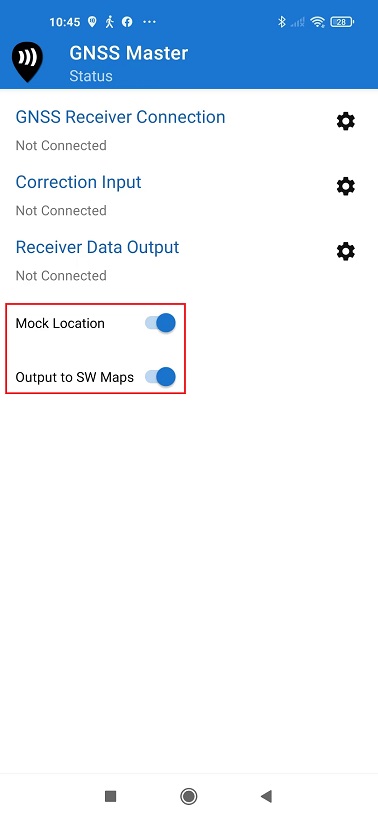
- Click the gear icon on the right side of GNSS Receiver Connection to enter the setup menu.
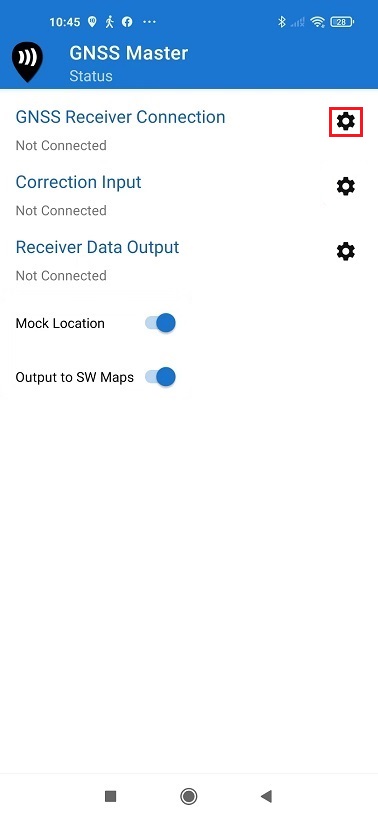
- Choose USB Serial at Mode. Set Baud Rate to 115200 bps (if you ordered your ArduSimple Proofessional kit before 09.10.2023, set Buad Rate to 38400 bps. If you use a different receiver, the Baud Rate should match with your receiver configuration). At Connected USB Device, it will automatically recognize your receiver with name ***** USB UART.
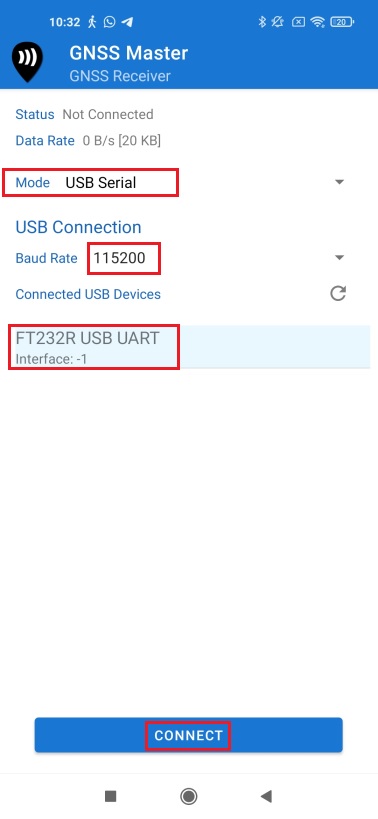
- Press CONNECT.
- Power your RTK receiver by connecting USB cable to the power supply (smartphone/tablet/ compatible powerbank). If you get any popup message to connect the USB device with any app, you can ignore it.
- Enable your smartphone/tablet Bluetooth, and pair it with your RTK receiver. When pairing your device, notice that it may appear as RTK_GNSS_*** or as a generic MAC number (e.g.: F0:0A:95:9D:68:16). The password is always 1234. The pairing only needs to be done once.
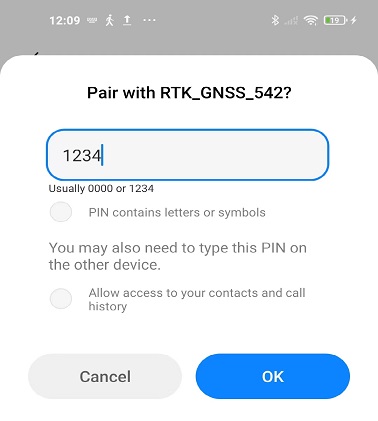
- Open GNSS Master app. Check Mock Location and Output to SW Maps.

- Click the gear icon on the right side of GNSS Receiver Connection to enter the setup menu.

- Choose Bluetooth at Mode. In Paired Devices chose the one you paired in step 8. Press CONNECT.
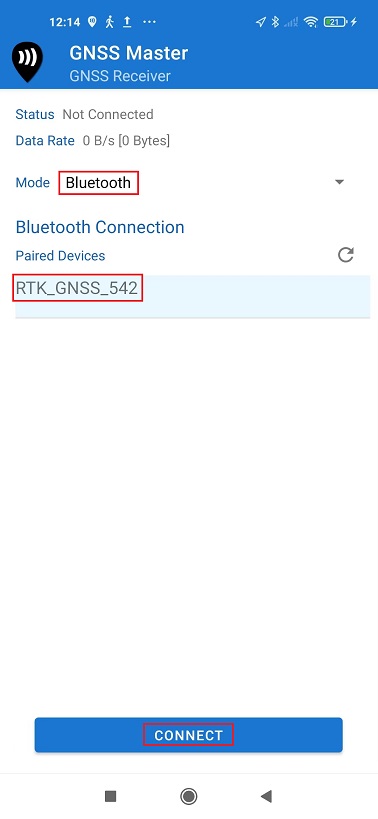
- Go back to main menu. Now you should see in GNSS Receiver Connection it says Connected and with data transfer.
- Open Correction Input by clicking on the gear icon.
- In Mode choose NTRIP Client and press the + button next to NTRIP Connections.
- Set your NTRIP Client credentials (Caster IP, Caster Port, Username and Password). If you don´t know how to do it, have a look at this tutorial. Press SAVE.
- Press CONNECT. In Status you will see GNSS Receiver Connection and Correction Input showing Connected and with data communication.
- You can check your location and available satellites in Skyplot.
- Open your favorite GPS/GNSS application and use it as usual.
You will be using the external RTK GNSS receiver instead of the smartphone/tablet internal GPS receiver. Following image is the example of SW Maps.
- We have tested this functionality with many apps, you can find them in this link.
If you test it in other apps, you can send us an email at info@ardusimple.com and we will add it to the list.
The Android robot is reproduced or modified from work created and shared by Google and used according to terms described in the Creative Commons 3.0 Attribution License.
Now you are ready to survey and map!
Related tutorials
Accessories
Here you can find affordable accessories for RTK Calibrated Surveyor Kit.
-
Accessories
Waterproof Transport Case IP67
From 59,00€ Select options This product has multiple variants. The options may be chosen on the product page
 and
and 

